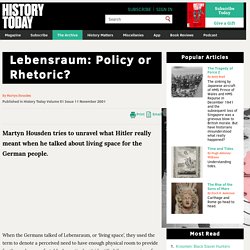

David Olusoga: ‘Black soldiers were expendable – then forgettable’ Although the guns on the western front fell silent, literally with military precision, at the striking of the 11th hour on 11 November 1918, the end of war did not mark the coming of peace.

My Adopted Soldier. WWI. In-between World Wars. WWII. GCSE Modern World History. The Best And The Weirdest U.S. Propaganda Posters from WWI and WWII. Every country with a major involvement in World War I and II produced war propaganda posters.

The U.S. alone produced hundreds of different posters with wide-ranging messages. Ten Pound Poms - A Ticket to Australia for Just Ten Pounds. Post World War II British Migration to Australia. Summary Between 1947 and 1982, over a million Britons emigrated to Australia, the majority of whom travelled under the ten pound assisted passage scheme funded by the British and Australian governments.

Between 1947 and 1981, over a million Britons emigrated to Australia, the majority of whom travelled under the ten pound assisted passage scheme funded by the British and Australian governments (Hammerton; Thomson, 2005). This large intake of British migrants was encouraged as part of Australia's 'populate or perish' nation-building initiative, which emerged in the aftermath of World War II (Tavan, 2005). Stories from our collection. Ten Pound Poms: Immigration Museum. Skip to main content Calling all Ten Pound Poms, Nest Eggs and British migrants!

10 September, 2016. My grandfather died fighting for Hitler. What should we make of his legacy? - RN. As a kid, I knew my grandad had fought in World War II.

There were reminders of him around the house: the old wristwatch, the strange old, scratchy, grey wool blanket that he supposedly sent back from the war. But it wasn't until Anzac Day at primary school that I realised he hadn't fought on the same side of the war as other Australian grandads. He was Joachim — to us, Achim — a German who died fighting for Hitler's Wehrmacht, the German army, on the Eastern Front in January 1945. Over 50 years later, my two brothers and Dad retraced Achim's last footsteps on a train that wound its way through south-west Poland. Outside it was -30 degrees, one of Europe's coldest winters since January 1945. ‘Too Dark to See’ documentary sheds new light on black diggers. This year, Western Sydney University and the Australian War Memorial are correcting the record with the documentary, ‘Too Dark to See’.

But the project is not just a film - it also includes a photographic exhibition and a commemorative book, published in time for Remembrance Day. The works celebrate Indigenous soldiers by recounting their personal stories. Melissa Williams from Western Sydney University’s Office of Aboriginal & Torres Strait Islander Employment & Engagement, told NITV the film “is to commemorate Aboriginal and Torres Strait Islander people and really to honour their contribution.”
The film features war veteran, uncle Cliff Daylight. He explains, “Aboriginal people have fought the boar war, malaysian conflicts, first and second world war, Vietnam. Who were the Black Diggers? Nearly 4,000 Indigenous people officially served during World War II (1939-1945), according to historian Robert Hall.

Of those, about 3,000 were Aboriginal people and 850 Torres Strait Islander people. Other accounts suggest as many as 5,000 Indigenous people served. Dr.Seuss political cartoon. Lebensraum: Policy or Rhetoric? When the Germans talked of Lebensraum, or ‘living space’, they used the term to denote a perceived need to have enough physical room to provide for themselves comfortably.

In particular, it identified the possession of enough land to feed a population large enough to ensure Germany a place on the world stage. Hitler did not just start talking about the need to conquer Lebensraum in 1941; its origins lay much further back than even 1939. Anti-Nazi newspaper columnists (for example in Der Deutsche in Polen) observed during the late 1930s that Hitler’s foreign policy involved something more than just planless initiatives, improvisation and contradictory imperatives. They said that its main direction had been well-established during the mid-1920s. The second volume of Mein Kampf, published in December 1926, contained a chapter entitled ‘Eastern Orientation and Eastern Policy’.
German History in Documents and Images. BBC History - BBC History. Interactive Maps. JCS Online Resources. The acclaimed Churchill Archive is now free for the first time to schools worldwide thanks to a $1 million donation from philanthropist Laurence Geller CBE.

"All children should understand Sir Winston Churchill’s fundamental place in our nation’s history,” says the Rt Hon Nicky Morgan MP, Secretary of State for Education and Minister for Women and Equalities, "and schools can now seize the opportunity to access the Churchill Archive – a tremendous cache of documents that bring history to life.”
Opening up exciting new opportunities for the teaching and learning of History at secondary level, the Churchill Archive - described by History Today as "the real gem of online Churchill resources" - offers cross-searchable online access to over 800,000 original documents. Highlights include: Operation CLICK. The Operation CLICK resource book is provided here in PDF file format in 11 separate downloadable files.

Files require the Adobe Reader or other PDF reader to view. Get the free Adobe Reader (link opens in a new window) Introduction to Operation CLICK 10 pages 590KB Topic 1Into battle: Australia goes to war 10 pages 750KB Topic 2Impressions of war: Telling the story 6 pages 490KB. Australia's Wartime History - Digital Education Resources.
Imperial War Museums. US Comic Book Propaganda. Aerial Propaganda Leaflet Database. German Propaganda Archive (Guide Page) Nazi and East German Propaganda Guide Page Propaganda was central to Nazi Germany and the German Democratic Republic.